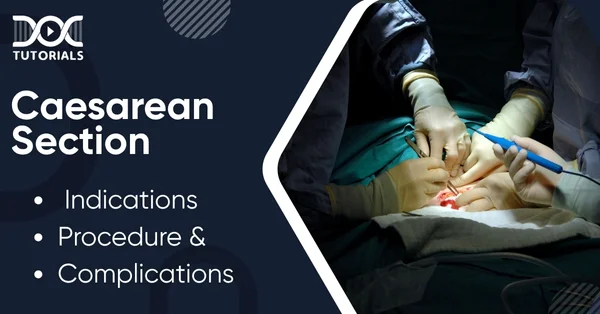Caesarean Section: Indications, Procedure, and Complications

Even though previously performed as a last option, LSCS delivery or C-sections are now much more prevalent worldwide. According to research by the World Health Organisation (WHO), C-section deliveries represent over 1 in every 5 births in the world (21%) and is expected to increase to almost a third (29%) by 2030.
Though this procedure may be essential and even life-saving in some circumstances, performing it without a medical indication can expose both the mother and the baby to unnecessary short- and long-term health risks. That’s why having a clear understanding of the indications, surgical steps, and potential complications of a caesarean section is vital for both immediate care and long-term maternal and neonatal outcomes.
Studying topics such as caesarean sections is essential for NEET PG candidates to not only pass the exam but also establish a strong clinical foundation for professional practice.
Continue reading to learn more!
What is a Caesarean Section?
A caesarean section, or C-section, is a type of surgical delivery in which a baby is delivered through incisions on the mother’s abdomen and uterus. It is performed if vaginal delivery is not safe or feasible.
C-sections are planned in the event of pre-warning of complications or during surprise complications at the time of delivery. In normal pregnancy, normal delivery is still the safest and most ideal for the majority of mothers and newborns. Two out of three deliveries are vaginal, by statistics.
What are the Different Types of Caesarean Sections?
Caesarean deliveries can differ depending on where and to what extent an incision is made in the uterus. Subsequently, it also makes sense to ask your obstetrician what kind of incision was made. This knowledge will come in handy when planning further pregnancies.
Essentially, there are 2 types of cesarean sections:
- Lower Segment Incision
This is employed most frequently. It includes a horizontal cut through the lower abdominal wall (termed a “bikini cut” in most instances) and a horizontal cut on the lower aspect of the uterus. This is an incision that heals well, causes minimal scarring, and is associated with fewer complications in subsequent pregnancies.
- Classical Incision
This method involves a vertical incision on the uterus. The abdominal cut can be either vertical or horizontal. It’s typically reserved for urgent situations or exceptional cases, such as:
- When the placenta is positioned very low
- The baby is in a transverse (sideways) position, or
- The baby is especially small
However, it may increase the risk of complications in future pregnancies and births.
When Would a C-Section Be Necessary?
A C-section can be recommended in some medical conditions or when there is a complication that renders safe vaginal delivery infeasible. Some of the most frequent indications of cesarean section include:
- Slowed Labour Progress: One of the most frequent indications for conducting a C-section is when progress in labour slows down or stops. This includes prolonged cervix opening time or prolonged pushing following complete dilation of the cervix.
- Fetal Distress: If there is the possibility of a problem with the baby’s heart rate, surgical delivery is the preferred choice.
- Abnormal Fetal Positioning: Babies positioned breech (feet or buttocks) or transverse (side) can be delivered through a C-section to ensure safety.
- Multiple Births: If more than one baby is being carried, especially if the babies are not head-down and/or labour begins too prematurely, a C-section is the preferred choice.
- Placenta Complications: Such conditions as placenta previa, in which the placenta lies over the cervical opening, usually require a C-section.
- Maternal Medical Complications: Women with certain health conditions, such as heart disease or neurological disorders, may benefit from a surgical delivery.
- Obstruction of the Birth Canal: Large uterine fibroids, pelvic deformities, or fetal deformities like hydrocephalus can block a vaginal delivery.
- Previous Uterine Surgery: If you have had a previous C-section or uterine surgery, your physician may recommend a repeat C-section, but in certain instances, vaginal delivery after caesarean (VBAC) can be achieved.
What Happens During a Caesarean Section?
A lower segment caesarean section will typically be performed in a clean operating room, e.g. an operating theatre or a specially prepared delivery room. The actual procedure may vary depending on your individual health needs and the practices followed by your care team.
In the majority of cases, you will remain conscious during the procedure. You’ll get only general anaesthesia in unusual cases, which makes you unconscious. More frequently, you get spinal or epidural anaesthesia—this will numb the pain in your lower half but keep you awake and alert, allowing you to witness your baby’s birth.
General LSCS procedure steps include:
- You’ll be given a hospital gown to wear after removing your own clothes.
- You will lie on a surgical or examination table.
- A catheter will be inserted into your bladder if it is not already in place.
- An IV line will be inserted into your hand or arm to deliver medications and fluids.
- Safety straps may be used to secure your legs on the table.
- The lower abdominal area is usually trimmed and disinfected with an antiseptic solution before the surgery.
- A sterile covering will be placed over your abdomen, and a screen will be set up near your chest to block your view of the surgery.
- Throughout the procedure, an anaesthesiologist or nurse anaesthetist will monitor your vital signs like your heart rate, oxygen saturation, and blood pressure.
- After the anaesthesia has fully taken effect, a cut is made either horizontally or vertically just above the pubic region.
- The surgeon carefully cuts through skin, fat, and muscle to reach the uterus, then makes a final incision in the uterus itself—this can also be horizontal or vertical.
- The amniotic sac is opened, and your baby is gently delivered. You might feel pressure or tugging.
- The umbilical cord is clamped and cut.
- Medicine may be administered through your IV to help the uterus contract and aid in delivering the placenta.
- The placenta is taken out, and the uterus is examined for retained tissue or damage.
- The uterine incision is closed with suturing.
- Other layers of tissue and muscle are sewn together, and your skin incision is closed by stapling it using surgical staples.
- A sterile dressing is placed to conceal the site of the incision.
What are the Risks of a C-Section?
Like any surgery, a caesarean has certain risks. While most procedures are completed without complications, LSCS procedures generally have a slightly higher risk profile compared to vaginal births. Some possible complications include:
- Infection may occur at the surgical site or within the uterus.
- Bleeding too much (haemorrhage).
- Development of blood clots.
- Injury to surrounding organs by accident, such as the bladder or intestines.
- Thinning of the uterine wall from cuts.
- Anaesthesia complications or reactions.
- Injury to the baby by accident from the cut.
Other C-Section Challenges:
Recovery after LSCS delivery can be more uncomfortable and longer than vaginal delivery.
- You are likely to experience long-term pelvic pain.
- The first breastfeeding might be more challenging.
- Newborns delivered by C-section may be at greater risk of respiratory distress at birth.
How Long Does It Take to Recover from a C-Section?
Here is an overview of the recovery phase after a C-section:
- After the anaesthesia has worn off following a cesarean section, you will start to feel discomfort at the incision site.
- You will also experience gas pains and shallow breathing.
- For the first three or four days, an adult will need to accompany you to assist you in getting in and out of bed.
- Patients typically remain in the hospital for two or three days following surgery.
- Full recovery typically takes around four to six weeks.
- Be sure to talk to your healthcare provider about what to expect during this period.
- Many providers advise avoiding stairs, heavy lifting, physical exertion, and exercise for several weeks.
- Take the help of your partner, family, or friends with chores like cooking, cleaning, and shopping to give your body time to heal.
- Your doctor might also restrict driving until you’re comfortable turning your body and using the pedals without pain.
Here are some additional factors to keep in mind:
- You would experience cramping and vaginal bleeding that lasts up to six weeks, and a little tenderness around your incision is fine.
- Pain will generally be treated with over-the-counter pain medication like ibuprofen or acetaminophen.
- Abstinence from sex for a minimum of six weeks or until your provider indicates it’s okay is ideal.
- After surgery, you will also have discharge known as lochia from the shedding of the uterine lining.
- The discharge is initially reddish in colour and, subsequently, after a while, turns yellow.
- If there is severe bleeding or a foul odour in the discharge, report it to your provider.
- Sanitary pads should be used in the healing process and not tampons until the bleeding ceases completely.
FAQs About Caesarean Section
- What is another term for a Caesarean section?
Caesarean section—commonly referred to as C-section—is also called cesarean delivery. It is a form of surgical delivery to bring forth one or more babies by incising the abdominal wall and the uterus of the mother.
- What are the indications for a C-section?
A C-section would be advised for pregnant women with certain medical conditions. These are severe health issues like heart or neurological disease. It could also be unavoidable in the event of physical blockages, like a huge fibroid in the uterus or a fractured pelvis, or when the unborn child has an illness like severe hydrocephalus leading to an enlarged head, with vaginal delivery being unsafe.
- In what particular circumstances will a planned C-section be called for?
Certain pregnancies face complications that require a Caesarean section by necessity. One such traditional complication is cephalopelvic disproportion (CPD), whereby the baby’s head or body is too large to fit through the mother’s pelvic canal or the mother’s pelvic canal is too small to successfully achieve a vaginal birth. In these instances, a C-section offers a safer alternative for mother and child.
- What anaesthesia is most often used for a C-section?
Spinal anaesthesia, also called a spinal block or subarachnoid block, is commonly used for planned C-sections and is the preferred choice for most women.
- What should be avoided after a C-section?
After a C-section, it’s essential to prioritise rest, especially when your baby is asleep. For the first few weeks, avoid lifting anything heavier than 10 to 15 pounds. Pain management is crucial, and your healthcare provider might recommend medications like ibuprofen (Advil, Motrin IB), acetaminophen (Tylenol), or other suitable pain relievers to support your recovery.
Conclusion
Caesarean sections can be necessary to maintain the safety and health of the mother and baby. If you’re scheduled for an LSCS surgery, your obstetrician will guide you through what to expect during the procedure and how to manage the post-operative recovery.
If you are a medical student who wants to excel in the NEET PG exam, studying procedures such as C-sections is essential. DocTutorials gets you ready with the whole guidance in the form of video lectures from experts, quick revision programs (QRPs), and interactive learning sessions—so you’re both exam-prepared and clinically capable. Start your NEET PG preparation with DocTutorials today!
Latest Blogs
-

NEET PG Exam 2025- Date, Pattern, Marking Scheme, Subject Wise Weightage, and Exam Mode
NEET PG Exam 2025 is the ultimate gateway for medical graduates aspiring to pursue postgraduate courses in medicine, including MD,…
-

INI CET Exam 2025: Your Roadmap to Success – Key Topics, Strategies, and Lessons from Last Year’s Papers
The INI CET exam is more than just a test; it’s a significant milestone for many medical students aiming to…
-

INI CET Exam Success: Previous Year Question Papers & Ultimate Guide – INI CET PYQ
One can feel overwhelmed while preparing for the INI CET (Institute of National Importance Combined Entrance Test). A vast syllabus,…




